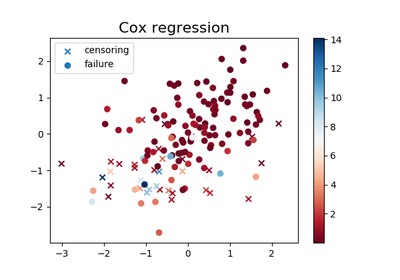tick.survival.SimuCoxReg¶
-
class
tick.survival.SimuCoxReg(coeffs: numpy.ndarray, features: numpy.ndarray = None, n_samples: int = 200, times_distribution: str = 'weibull', shape: float = 1.0, scale: float = 1.0, censoring_factor: float = 2.0, features_type: str = 'cov_toeplitz', cov_corr: float = 0.5, features_scaling: str = 'none', seed: int = None, verbose: bool = True, dtype='float64')[source]¶ Simulation of a Cox regression for proportional hazards
- Parameters
coeffs :
numpy.ndarray, shape=(n_coeffs,)The array of coefficients of the model
features :
numpy.ndarray, shape=(n_samples, n_features), default=`None`The features matrix to use. If None, it is simulated
n_samples :
int, default=200Number of samples
times_distribution :
str, default=”weibull”The distrubution of times. Only
"weibull"is implemented for nowscale :
float, default=1.0Scaling parameter to use in the distribution of times
shape :
float, default=1.0Shape parameter to use in the distribution of times
censoring_factor :
float, default=2.0Level of censoring. Increasing censoring_factor leads to less censored times and conversely.
features_type :
str, default=”cov_toeplitz”The type of features matrix to simulate
If
"cov_toeplitz": a Gaussian distribution with Toeplitz correlation matrixIf
"cov_uniform": a Gaussian distribution with correlation matrix given by O.5 * (U + U.T), where U is uniform on [0, 1] and diagonal filled with ones.
cov_corr :
float, default=0.5Correlation to use in the Toeplitz correlation matrix
features_scaling :
str, default=”none”The way the features matrix is scaled after simulation
If
"standard": the columns are centered and normalizedIf
"min-max": remove the minimum and divide by max-minIf
"norm": the columns are normalized but not centeredIf
"none": nothing is done to the features
seed :
int, default=NoneThe seed of the random number generator. If
Noneit is not seededverbose :
bool, default=TrueIf True, print things
- Attributes
features :
numpy.ndarray, shape=(n_samples, n_features)The simulated (or given) features matrix
times :
numpy.ndarray, shape=(n_samples,)Simulated times
censoring :
numpy.ndarray, shape=(n_samples,)Simulated censoring indicator, where
censoring[i] == 1indicates that the time of the i-th individual is a failure time, and wherecensoring[i] == 0means that the time of the i-th individual is a censoring timetime_start :
strStart date of the simulation
time_elapsed :
intDuration of the simulation, in seconds
time_end :
strEnd date of the simulation
dtype :
{'float64', 'float32'}, default=’float64’Type of the generated arrays. Used in the case features is None
Notes
There is no intercept in this model
-
__init__(coeffs: numpy.ndarray, features: numpy.ndarray = None, n_samples: int = 200, times_distribution: str = 'weibull', shape: float = 1.0, scale: float = 1.0, censoring_factor: float = 2.0, features_type: str = 'cov_toeplitz', cov_corr: float = 0.5, features_scaling: str = 'none', seed: int = None, verbose: bool = True, dtype='float64')[source]¶ Initialize self. See help(type(self)) for accurate signature.
-
simulate()[source]¶ Launch simulation of the data
- Returns
features :
numpy.ndarray, shape=(n_samples, n_features)The simulated (or given) features matrix
times :
numpy.ndarray, shape=(n_samples,)Simulated times
censoring :
numpy.ndarray, shape=(n_samples,)Simulated censoring indicator, where
censoring[i] == 1indicates that the time of the i-th individual is a failure time, and wherecensoring[i] == 0means that the time of the i-th individual is a censoring time
